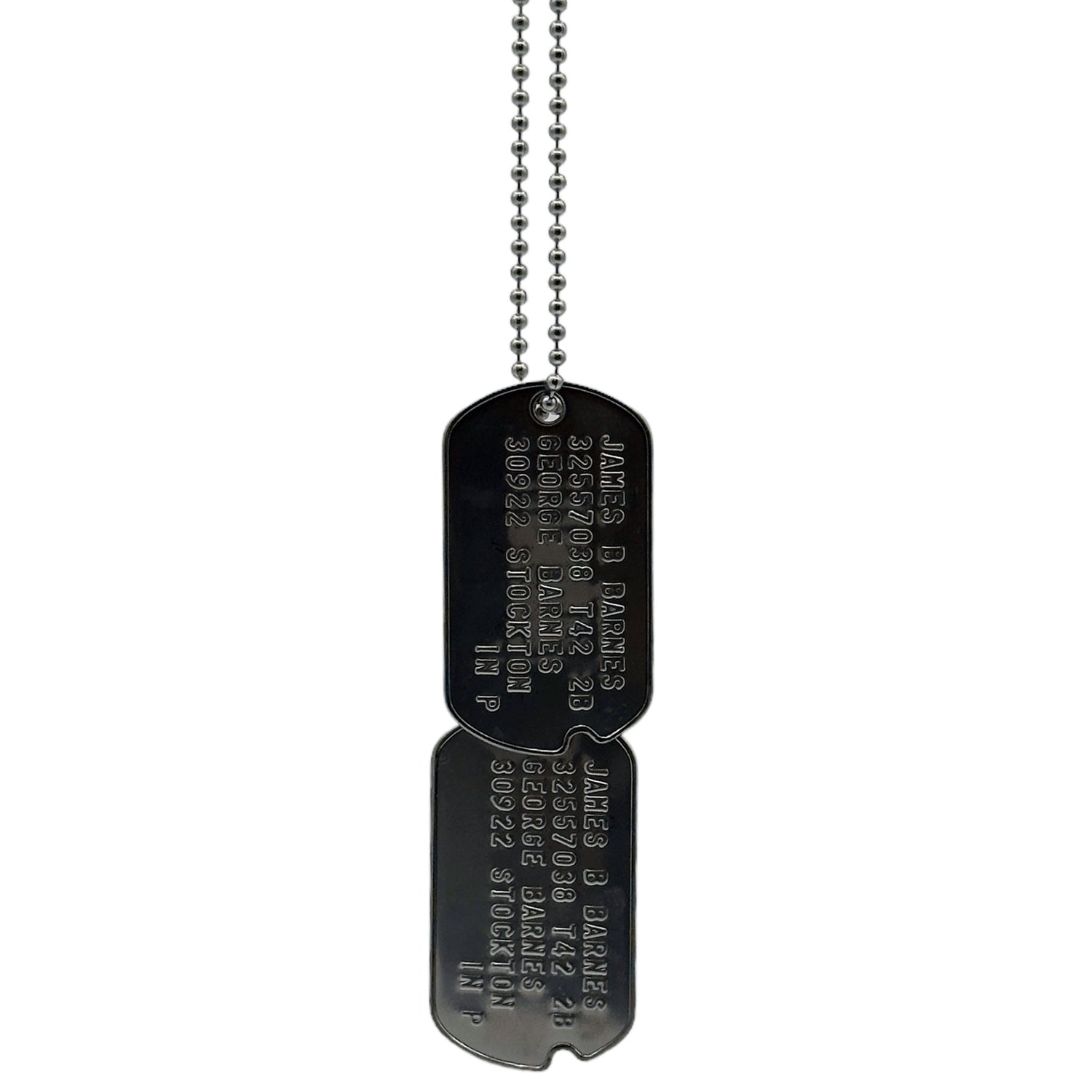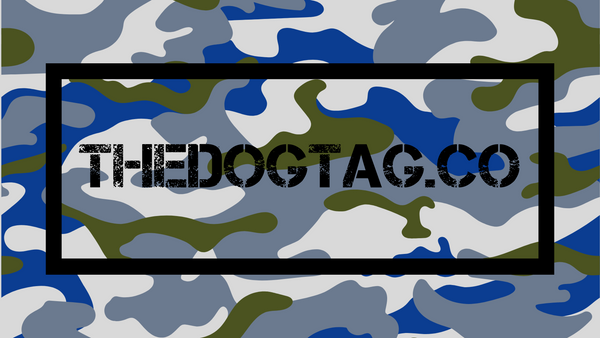Military dog tags, a symbolic insignia worn by U.S. service members, transcend their physical size to carry immense historical, practical, and emotional weight. These unassuming metal tags, with their standardized information format, serve as indispensable identification tools on the battlefield. This article explores the intricate tapestry of U.S. military dog tags, from their historical roots to their contemporary significance across different branches.
History of Military Dog Tags
The origins of military dog tags can be traced back to the tumultuous times of the Civil War. In the absence of a formal identification system, soldiers resorted to makeshift methods, such as pinning notes to their uniforms. The inherent challenges and inefficiencies of these ad-hoc approaches became evident with the rising casualties. Subsequently, during World War I, military leaders recognized the urgent need for a standardized identification system, leading to the formal adoption of military dog tags. This historical evolution mirrors the ever-changing landscape of warfare and the constant quest for improved identification methods.
Purpose and Importance
The primary purpose of military dog tags extends beyond simple identification; they are a lifeline for soldiers on the front lines. In moments of chaos and confusion, these tags ensure the fallen are properly acknowledged, and their families are swiftly notified. Furthermore, they play a pivotal role in administrative processes, streamlining record-keeping and facilitating the efficient tracking of personnel movements.
Standard Format and Information
The standardized format of military dog tags encompasses critical details such as the individual's name, blood type, religious preference, and a unique identification number. This uniformity ensures that regardless of the branch of service, medical personnel and other officials can quickly interpret and act upon the information during emergencies.
Evolution of U.S. Military Dog Tags by Branch
The evolution of military dog tags has been a fascinating journey, adapting to the changing needs and advancements in technology over the years. Initially conceived during the Civil War as makeshift identification methods, dog tags underwent significant standardization to become the essential identification tool we recognize today.
- Army Dog Tags
The evolution of Army dog tags epitomizes the commitment to durability and efficiency. Modern iterations often use materials like aluminum or stainless steel for resilience in diverse environments. Laser engraving technology provides a clear and long-lasting imprint of crucial information. Personalized touches, reflecting the rich traditions of the U.S. Army, are available in options like personalized Army dog tags.
- Navy Dog Tags
Navy dog tags, designed for the challenges of maritime environments, showcase innovation in material science. Resistant to corrosion caused by saltwater exposure, these tags are crafted from robust materials, ensuring longevity.
- Air Force Dog Tags
Air Force dog tags are tailored to meet the distinctive needs of aviation personnel. In addition to standard identification information, these tags may incorporate details pertinent to air operations. The emphasis on durability ensures that tags remain intact, even in the dynamic conditions encountered during flight. Explore a range of accessories to complement Air Force dog tags here, offering a touch of personalization.

- Marine Corps Dog Tags
Marine Corps dog tags embody ruggedness, reflecting the toughness of those who serve in this elite branch. The design prioritizes durability and readability, with distinct markings that carry the weight of Marine traditions. The consistency in Marine dog tag design over the years underscores the Marine Corps' commitment to its storied history.
- Coast Guard Dog Tags
Coast Guard dog tags serve a dual purpose, providing identification in both maritime and land-based environments. Evolving alongside technological advancements, Coast Guard dog tags incorporate modern materials. Delving into the Coast Guard's use of dog tags and understanding the significance of black dog tags is explored further in What Do Black Dog Tags Mean in the Military?.
- Emergency Medical Dog Tags
Beyond traditional identification, the Coast Guard employs emergency medical dog tags to enhance personnel safety. These specialized tags include critical health information, allergies, and emergency contacts. The use of such tags ensures that medical response teams can swiftly and accurately address health concerns during emergencies. For more insights into the importance of medical information on dog tags, the article Do Pilots Wear Dog Tags? provides valuable information.
- Special Forces Dog Tags
Special Forces, the elite units within the U.S. military, demand a unique set of dog tags that reflect the specialized nature of their missions. Special Forces dog tags are often crafted with precision and can be personalized to meet the distinct requirements of these highly trained units. The black color symbolizes the covert and specialized nature of their operations.

Materials and Manufacturing
The materials and manufacturing processes behind military dog tags have experienced a significant transformation. Traditionally stamped, modern dog tags often feature laser engraving for precise and enduring information. Materials such as aluminum and stainless steel contribute to the durability of these tags. Technological advancements continue to play a pivotal role in enhancing the quality and efficiency of dog tag production, ensuring they meet the rigorous standards of military use.
Regulations and Requirements
The military upholds stringent regulations regarding the information included on dog tags. This commitment to standardization not only ensures uniformity across branches but also adapts to changes in medical practices and technology. Adhering to these regulations is paramount to maintaining the efficacy of dog tags as rapid and reliable identification tools.
Unique Identification Features
Each set of dog tags features unique identification elements, such as the individual's social security number or a unique service number. These identifiers contribute to efficient and accurate identification, essential in the chaotic and time-sensitive nature of military operations. The use of unique identifiers streamlines administrative processes and guarantees precise identification.
Modern Technological Advances
The integration of technology into military dog tags is a testament to the military's commitment to efficiency and innovation. Some tags now incorporate QR codes or data matrix ID tags, enhancing the speed and accuracy of identification processes. These technological adaptations align with the military's dedication to leveraging advancements to improve operational effectiveness on every front.
Personalization and Customization
While adherence to strict standards is crucial, military dog tags also offer avenues for personalization. Individuals can add a touch of personality by incorporating specific mottos, quotes, or symbols. Explore a variety of personalized dog tag options, such as the gold ID dog tag set, allowing service members to express their individuality within the framework of military identification.

Notable Cases and Stories
The annals of military history are replete with poignant and heroic stories tied to the unassuming military dog tags. Each set of tags represents more than just identification; they encapsulate the journey, sacrifice, and bravery of those who wore them. These stories serve as a testament to the resilience and courage embedded in every service member's commitment to duty.
Collecting and Memorabilia
The significance of military dog tags extends beyond their functional use, transforming them into sought-after collectibles and cherished pieces of memorabilia. Enthusiasts and collectors can discover unique and authentic tags that offer a glimpse into the diverse narratives of those who served. Collecting military dog tags has become a tangible way to honor the legacy of service members and preserve their memory for future generations.
Conclusion
In conclusion, the saga of U.S. military dog tags unfolds as a multifaceted narrative of history, innovation, and individual identity. From their humble beginnings during the Civil War to the intricately designed, laser-engraved tags of the present day, the evolution of dog tags echoes the evolution of warfare and the military itself. These small, yet mighty, pieces of military identification encapsulate the spirit of service and sacrifice that defines the men and women of the U.S. military.
As technology progresses, these unassuming tags will undoubtedly continue to adapt to meet the demands of modern military service. The convergence of personalization options, technological integrations, and historical significance embedded in military dog tags makes them timeless artifacts. Whether worn by Army, Navy, Air Force, Marine Corps, Coast Guard personnel, or the elite forces with their specialized Special Forces dog tags, each set of dog tags tells a unique and enduring story within the broader narrative of U.S. military history, a testament to the bravery and dedication of those who proudly wear them.


